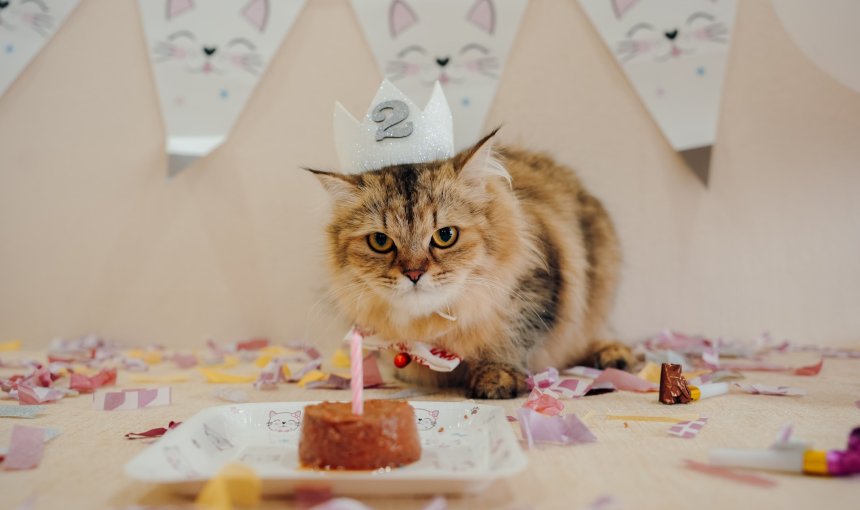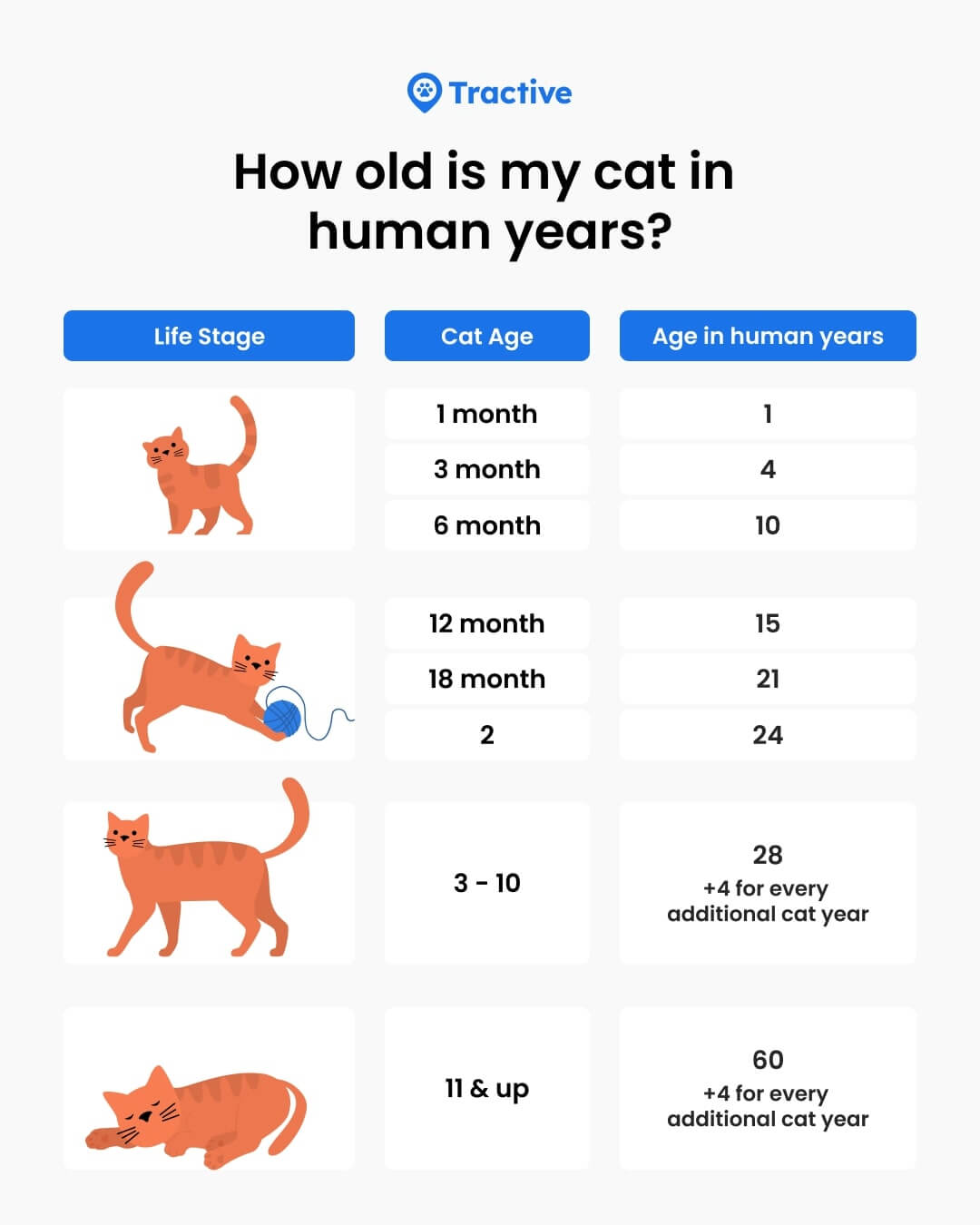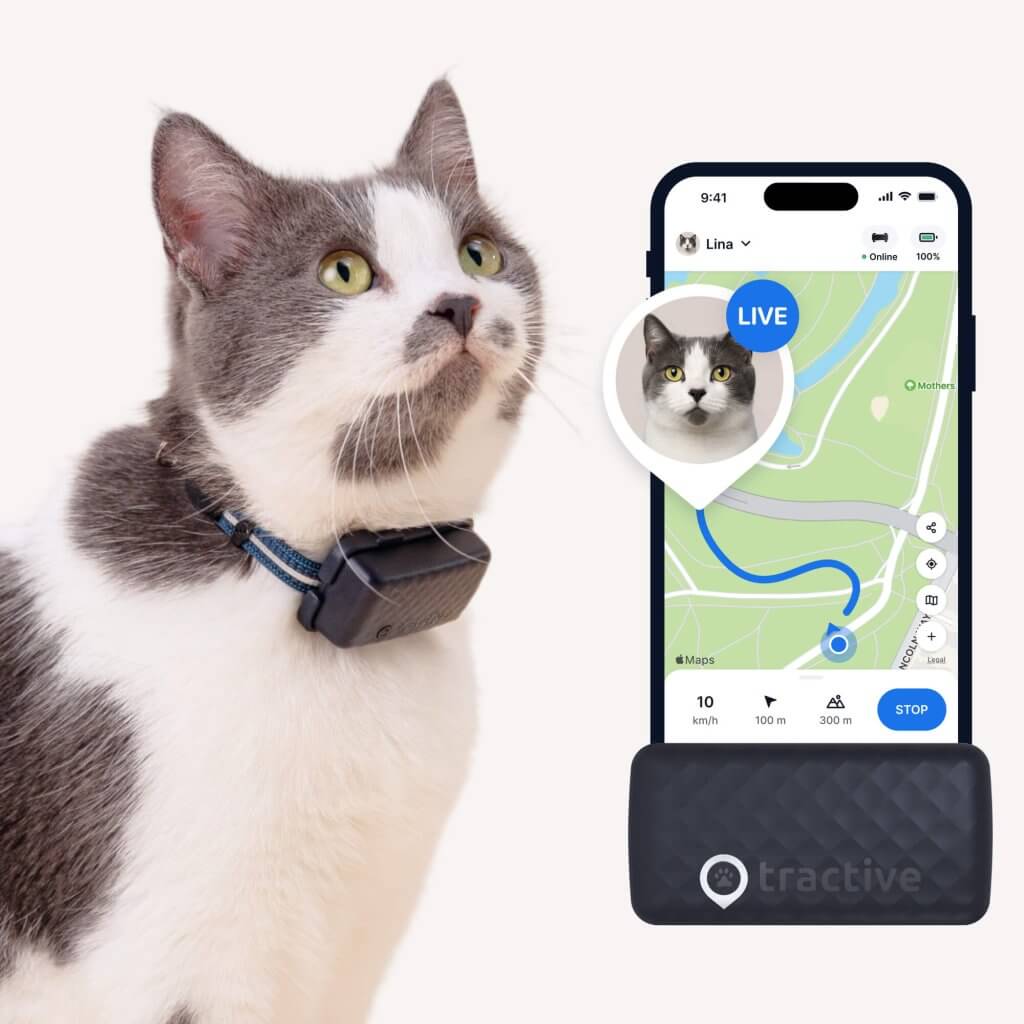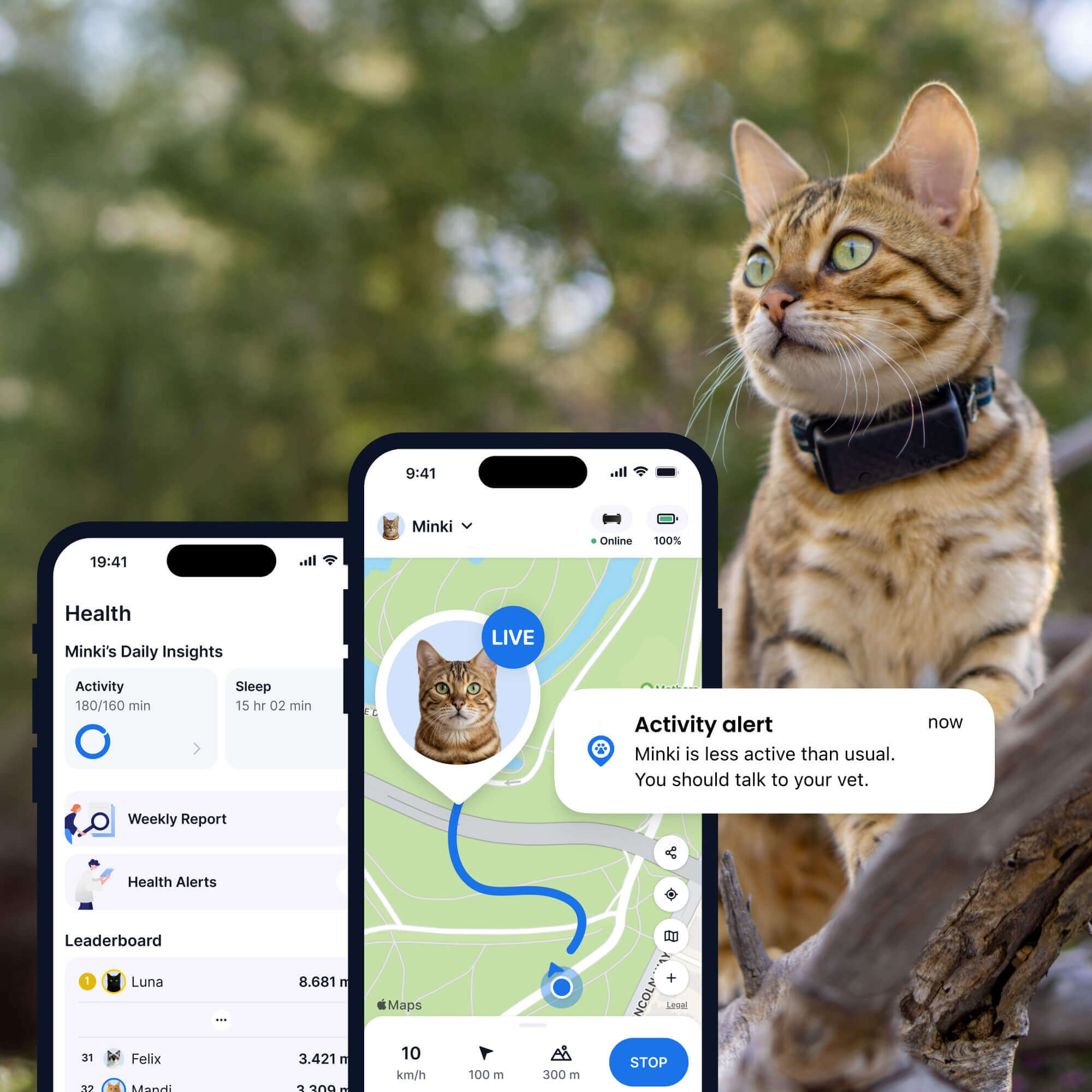Cat Years to Human Years: How Old Is My Cat?
Ever found yourself wondering: how old is my cat? Does it even matter? Turns out, figuring out your cat's age can help you better understand their needs - and help them live their best life. (Including understanding the reasons they might run away based on their age.)

If your cat is a rescue, you’re bound to find yourself wondering: how old is my cat? And while age may be nothing more than a number, figuring out cat years to human years can help you better anticipate their needs and help your cat live their best life. In this post, we cover how to cover cat years to human years, simple tips to figure out how old your cat is, the signs of a senior cat, how long cats live, and how you can help your cat live a long, happy, healthy life by your side.

Find out where your cat spends their time.
Read more- How to convert cat years to human years
- Cat years chart: Cat years to human years
- How to tell how old a cat is if you don’t know when they were born
- How to tell a cat’s age by their teeth
- What a cat’s coat says about their age
- Cat’s eyes & the aging process
- Muscle tone – another cat aging factor
- How do cats age?
- Signs of a senior cat
- How long can cats live? How long do cats live on average?
- Where a smart cat collar can help
How to convert cat years to human years
It’s difficult to draw a direct comparison between a cat’s age and its human equivalent. But the general consensus is that a cat ages the equivalent of 15 human years in the first year of their life. You might’ve heard of the “rule” that states that one human year = 7 cat years. And yes, to an extent, cats do age more quickly than humans – but not proportionately. Cats do mature quicker than humans in the beginning of their lives. But once they reach adulthood, their aging slows down.
By the end of their second year, a cat is thought to be the equivalent of 24 or 25 human years. From 2 years on, experts believe cats age at a rate of approximately 4 human years per cat year.
Cat years chart: Cat years to human years
Keeping track of your cat’s aging can be confusing. So we’ve created this handy chart to help you convert cat years to human years. Because if you understand how old your cat is, you can better understand what life stage they’re at – and better predict their needs.

For example, most girl cats go into heat around 6 months of age – or when they’re around 10 years old in human years. This can help you figure out if getting yours spayed is an option, so you can avoid an unwanted litter of kittens or even the risk your cat runs away from home!
How to tell how old a cat is if you don’t know when they were born
Here are a couple of your cat’s features that can help you figure out how old they are:
- Teeth
- Coat
- Muscle tone
- Eyes
Using the tips below, you can work to identify your cat’s life stage and then make an educated guess as to exactly how old your cat is.
How to tell a cat’s age by their teeth
Counting a cat’s teeth is a good place to start when trying to gauge their age. Once you determine whether the cat is a juvenile or an adult, you can use other characteristics to further narrow in on their age. Adult cats have 30 teeth, while kittens have 26 baby teeth (also known as deciduous teeth). Kittens develop their first teeth between 2 and 4 weeks of age. By 6 weeks of age, kittens should have all of their deciduous teeth. Between 4 and 7 months of age, the deciduous teeth are replaced by adult teeth.
The color of a cat’s teeth and the amount of tartar present can also help indicate how old they are. Cats between 1 and 2 years of age often have some yellowing on their teeth, but tartar buildup should still be minimal. Beyond 3 years, you may see tartar buildup around the base of each tooth. Dark stains on a cat’s teeth or missing teeth could indicate you’ve just adopted a senior cat (one over 11 years old).
This is not a perfect science though, since cats with excellent dental hygiene will not exhibit much tartar, regardless of age.
What a cat’s coat says about their age
As cats age, their coats often begin to show some gray. In cats with light-colored coats, this change may not be noticeable, but for cats with dark coats, you’ll begin to see some grey or white hairs where there weren’t any before. It’s also not uncommon for a cat’s fur to change texture as they get older. The fur may become thinner, less glossy, or more coarse. Sometimes these changes can be indicative of a health issue, such as kidney problems or malnutrition, so if you notice sudden changes, don’t hesitate to contact your veterinarian.
⚠️ Older cats may begin to neglect their frequent grooming routines, leaving their coat looking dirtier or duller than it otherwise would. And if they wander away from home, they may just come home with something infectious or messy stuck in their fur.
Cat’s eyes & the aging process
Clear, bright eyes are a sign of a young cat. As cats age, they may develop cataracts or glaucoma, leading to discoloration or cloudiness of their eyes. Senior cats often have more eye discharge than a kitten or adult cat. Sometimes a cat’s irises will change shape too, beginning to look jagged around the edges rather than smooth.
⚠️ Senior cats are vulnerable to progressive vision and hearing loss as they age. Watch out for behaviors like excessive meowing or vocalizing around nighttime – or if your outdoor cat takes longer to return home from their adventures.

Track your cat wherever they go
Get real-time location information, wherever they go. Find out when they go somewhere they shouldn’t, with Virtual Fences. And discover their favorite spots with Territory.
Muscle tone – another cat aging factor
Muscle tone is another indication of how old your cat is. Kittens are typically quite lean and have not yet accumulated much muscle mass. Healthy adult cats typically have good muscle tone. They shouldn’t have protruding bones, and their spine should be straight. Senior cats, on the other hand, might have lost some muscle. Their shoulder blades or hip bones might protrude more than previously.
Often, senior cats aren’t as active as they once were (perhaps due to the aches and pains of aging) and thus they spend more time sleeping and less time exercising. Naturally, this leads to a loss in muscle definition. But while some muscle loss is normal, excessive muscle loss could indicate a serious health issue. Cats with poor nutrition or health problems like kidney disease could struggle to maintain body weight and muscle tone. If you notice a sudden, significant decline in muscle mass in your aging cat, speak to your veterinarian.
How do cats age?
As you can see in the chart above, cats undergo the biggest age-related changes in the first couple of years of their lives. By the end of year one, cats are said to be comparable to a 15-year-old human. Within this period, a cat goes from a newborn kitten with closed eyes and no teeth to a young adult cat who has reached sexual maturity.
Cats’ reproductive development begins as early as 5-10 months. Their mating instinct is one of the key reasons they might run off to find themselves the purr-fect mate. By the end of year two, cats are said to age approximately 9 years – making them the equivalent of a 24-year-old human. Two-year-old cats have reached sexual maturity, and they have stopped growing. By this time they have accumulated muscle mass and are settling into their adult physique. After two years, cats age more gradually, at a rate equivalent to about 4 human years for each cat year.
Once cats reach about 11 years old they are considered senior citizens. They are now the equivalent of a 60-year-old human. Senior cats continue to age at a rate of about 4 human years per cat year. Around now, your cat may begin to show signs of aging, such as a decline in physique, graying fur, a drop in activity, and changes in their eyes, teeth, and coat.
Signs of a senior cat
As your cat transitions into senior status, it’s important to take note of any changes in their behavior. A drastic shift could indicate a serious health condition. For example, senior cats may exhibit:
- Stiffness and decreased mobility
- Cloudy eyes
- Dull coat
- Excessive eye discharge
- Weight loss and loss of muscle tone
- Frequent urination
- Confusion or disorientation – which might turn up as difficulties finding their way back home, especially if they’re an outdoor cat
Beyond physical decline, senior cats may also exhibit dementia. Some common signs of feline dementia include frequent meowing, disorientation, and excessive sleeping.
Senior cats can still have many wonderful years ahead of them, so don’t be discouraged or distraught if your cat is starting to slow down. Simple lifestyle tweaks, such as specially formulated food, regular activity, and sleep tracking can help your senior cat make the most of their twilight years.
How long can cats live? How long do cats live on average?
Cats have an average life expectancy of 16 to 18 years, though some cats may live even longer. In fact, according to the Cornell Feline Health Center, many cats live to be 20 or 21.3
In fact, certain cat breeds are known to have notably long life expectancies. Others are more susceptible to certain health issues than others. For example, both Siamese and Savannah cats are said to have a life span as long as 20 years.4 Meanwhile, Ragdoll and Persian cats are both susceptible to Polycystic Kidney Disease (PKD), which might lower their lifespan.5
Your cat’s habits also play a role in their longevity. According to the UC Davis Department of Veterinary Medicine, indoor cats are expected to live much longer than outdoor cats. This is largely because indoor cats face fewer hazards than cats who live outdoors. Outdoor cats usually have a big territory to patrol, defend, and even hunt in. Which means they’re vulnerable to threats like predators, traffic, toxins, and diseases from other animals that indoor cats may never come into contact with.
In the end, there’s no way of knowing how long your cat will live. However, small steps – like feeding your cat a balanced diet, keeping them active, and staying on top of their outdoor adventures – can help keep them safe and healthy well into old age.
Where a smart cat collar can help
A smart cat collar, like one from Tractive, can help you keep tabs on your cat’s activity and health – no matter their age or activity level. All steps that can help you help them live their longest, happiest, healthiest life by your side. By simply attaching a lightweight Tractive device to their collar, you can now:
- Track your cat’s activity and sleep.
Your tracker logs their active minutes, rest periods, and even estimated calories burned. A sudden, noticeable change – like way more sleeping or a total lack of playtime – is often the first sign that your cat isn’t feeling 100%. In these cases, your tracker will send you a Health Alert. Catching those shifts early means you can get them to a vet early.
- Keep them safe outdoors.
Tractive’s real-time GPS and Location History shows you exactly where your cat goes and how they use their territory. This is super helpful for keeping an eye on a senior cat who might be taking it easy or making sure a curious younger cat isn’t straying into risky territory. Plus, you can set up Virtual Fences to get instant alerts if they leave a safe zone.
Think of the smart collar as your wellness partner. It’s not just about finding your cat if they get lost; it’s about using tech to proactively monitor their daily well-being, which is the ultimate secret to giving a cat of any age a long and healthy life.





